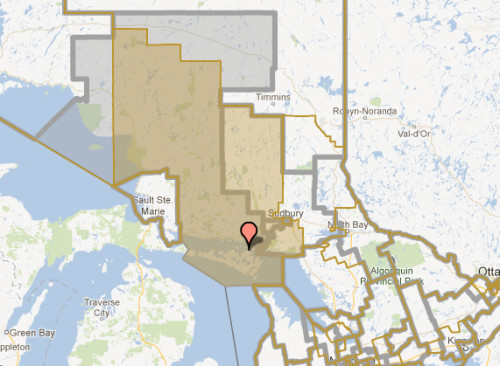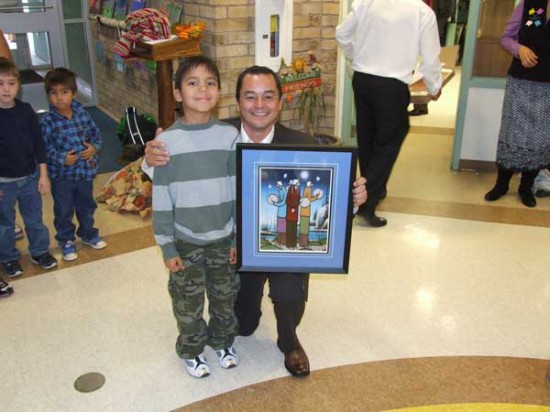SUDBURY––An Islander attending the electoral boundaries commission meeting in Sudbury on October 11 might easily have developed a bit of a rejection complex, as one after another representatives stood before the commission and argued against being forced into the riding new riding of Algoma-Manitoulin-Killarney.
The Honourable Justice George T. S. Valin, chair of the independent 2012 Federal Electoral Boundaries Commission for Ontario and his two co-commission members, Douglas Cloburne and Dr. Leslie Pal, arrived two hours late for the public hearings on the proposed new federal riding boundaries in Ontario––the meeting was originally scheduled for 2 pm, but flight delays kept the commission members and support staff in Thunder Bay. At one point the commission was even 15 minutes in the air before a mechanical issue on their Bearskin Airlines flight forced them to return to the airport.
Justice Valin apologized for the delayed start of the hearings, noting that the flight issues gave the commission a good appreciation of the challenges facing Members of Parliament in servicing their Northern Ontario ridings.
Justice Valin officially opened the hearings by introducing himself and his co-commissioners and discussing the constitutional and legislative requirements for the commission’s formation and the rationale under which it operates.
He explained that the Ontario Commission is one of 10 independent federal electoral boundary commissions created by law to redraw the boundaries of Canada’s federal electoral districts and went on to note that the work of readjusting Ontario’s federal electoral boundaries does not simply involve a mathematical exercise that is focussed simply on ensuring that each electoral district ends up with the same number of electors. Rather, he noted, it is a balancing act that must take into consideration communities of interest or identity as well as a district’s history and geographic size.
Ontario’s population has increased from 11,410,046 in 2001 to 12,851,821 in 2011 noted Justice Valin, and the Commission is currently formulating a proposal for Ontario’s 121 seats in the House of Commons to reflect the population growth and shifts. This represents an increase of 15 seats from the current 106.
The commission gave recognition to the immense size of Northern Ontario in its decision to maintain the current 10 seats in the North, which comprises over 90 percent of the province’s geographical area, but that increase has not gone unnoticed in the south.
“Not everyone is happy about that down south,” admitted the chair in a sentiment echoed by one of his fellow commissioners following the hearings in Sudbury.
The commission is committed to maintaining its decision to hold firm on the 10 seats for the North, and the electoral district of Kenora-Rainy River will remain largely intact in the new distribution, but the commission maintains the rest of the districts will require some major re-jigging in order to bring population numbers into better balance. Algoma-Manitoulin-Kapuskasing is particularly problematic. It is in trying to find the numbers to increase the riding population that most of the decisions to include Killarney, Lively, Coniston, Levack, and Onaping Falls within AMK’s boundaries came about.
“We need to find the numbers,” said Justice Valin. “We are open to suggestions on where to get them.”
Each and every one of the presenters standing before the commission prefaced and/or concluded their remarks with an expression of gratitude to the commission for their commitment to maintain 10 electoral districts in Northern Ontario. But each went on to make impassioned pleas to either maintain the status quo on riding boundaries, or to ensure that their communities were not included in the new AMK.
Almost all of the presenters seemed to have some connection to their current MPs, sometimes making remarks that indicated they wanted to keep their representation. This prompted Justice Valin to interject a number of times that there was no guarantee that any elected member in any riding would remain a region’s representative following a general election.
There were no representatives from AMK presenting at the Sudbury hearings. Sudbury MP Glen Thibeault mentioned to The Expositor that AMK MP Carol Hughes was visiting communities along the northern region of her riding (along the Highway 11 corridor) and would be making her presentation at the North Bay public hearings scheduled yesterday (October 16).
Nickel Belt MP Claude Gravelle joined his colleague NDP colleague Mr. Thibeault in exhorting the commission to maintain the same population exemption for AMK that it had provided to Kenora––and thereby essentially leave most of the rest of the riding boundaries static.
Barring maintaining the status quo, suggestions were made to add communities in the Sault Ste. Marie region to the Algoma riding, with which it was alleged those communities share more of a historical and cultural affiliation with AMK than Lively, Coniston or the Levack regions, whose close historical and economic attachments to the Sudbury and Nickel Belt ridings would suggest those communities would feel more at home if appended or remaining there.
Much was made of the distances that residents of Coniston, particularly seniors, would face in reaching a constituency office in Elliot Lake. It was noted that such electors would be forced to pass riding offices in both Nickel Belt and Sudbury in order to reach the AMK offices in Elliot Lake––these residents are currently used to being able to access their current representative by public transit.
Justice Valin noted that the placement of constituency offices could be adjusted by MPs.
It was presented to the commission that MP budgets have been trimmed by six percent and future budgets look to be even leaner, making maintaining current services even more difficult, let alone taking on more geography.
A number of presenters noted that their communities would be divided up in a number of different ridings, bringing confusion to the issue as to which representative an elector should approach for assistance.
Confusion was also cited as a danger for electors as to which polling station they should attend. Pauline Renault, a veteran returning officer cautioned that there are a vast number of similarly named streets that would be encompassed within the new boundaries, compounding an existing problem. “At least at present, we can usually tell which riding the voter is in by their postal code,” she said. But with many rural communities, that method will be in jeopardy.
Justice Valin noted that many of the concerns and suggestions brought forward had been already considered by the commission, but he readily admitted that the commission had not fully considered or evaluated the idea of the Sault Ste. Marie communities along Highway 17 that might have a comfortable historical connection to Algoma.
Justice Valin noted that the commission has not set the proposed boundaries in stone, and that the hearings have given commissioners some ideas they would seriously consider. He suggested that those interested in having their concerns heard by the commission should go ahead and send those comments in.
“As long as we have not concluded our work, we will consider those suggestions,” he said.
Justice Valin alluded to a possibility that the commission would be given an extension of its deadline to come up with the final submission for the House to consider. He said that considering the size of the job facing the commission, he was confident that extension would be granted.





